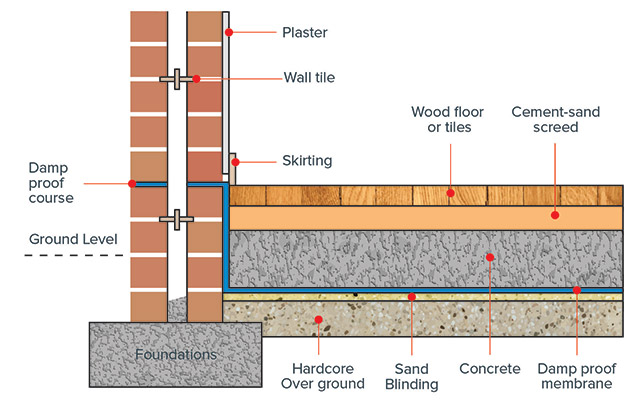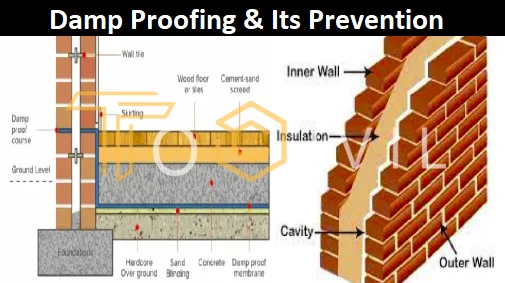Comprehensive list for damp specialist newcastle to identify moisture issues early
Comprehensive list for damp specialist newcastle to identify moisture issues early
Blog Article
Discovering the Various Strategies and Solutions for Effective Damp Proofing
Wetness in structures poses significant obstacles to both structural integrity and interior air top quality. Numerous techniques and services have emerged to fight this prevalent concern. From typical damp-proof membranes to ingenious chemical treatments, each method provides distinct benefits. Understanding these options is vital for reliable dampness control. Nevertheless, choosing the appropriate service relies on certain structure conditions and demands, prompting more exploration right into one of the most reliable moist proofing strategies available.
Comprehending the Causes of Moisture
Although dampness can occur from various sources, comprehending these causes is essential for effective removal. Frequently, wetness stems from three primary resources: increasing damp, penetrating moist, and condensation. Rising wet occurs when groundwater travels upwards with permeable materials, such as block or rock, usually because of an absence of a reliable barrier (mould removal newcastle). Permeating wet is usually triggered by outside aspects, consisting of roofing system leakages, defective rain gutters, or harmed walls, enabling water to infiltrate a residential property. Condensation, on the other hand, arises from excess wetness airborne, typically intensified by bad air flow and temperature differences, leading to water beads developing on surface areas. Identifying these underlying concerns is vital, as each kind of wetness needs a customized technique for removal. Appropriate assessment assists in establishing the most reliable remedies, ultimately guarding the architectural integrity of a structure and improving interior air top quality
Conventional Damp-Proof Membranes

Chemical Damp-Proofing Solutions
Chemical damp-proofing solutions provide an innovative approach to avoiding moisture breach in structures. These techniques normally entail the application of fluid chemicals that pass through masonry and develop an obstacle against rising moist. Frequently made use of chemicals consist of silanes, siloxanes, and various other water-repellent representatives that respond with surface materials to create a hydrophobic layer.The application process generally calls for boring holes into the wall surfaces, infusing the chemical service, and allowing it to heal. This technique is specifically beneficial for older structures where traditional damp-proof membranes might be unwise. Chemical damp-proofing can be less disruptive and much more economical than substantial restoration projects.While reliable, these remedies depend on correct application and ecological conditions for peak performance. damp removal newcastle. Regular upkeep and tracking are important to assure the durability of the damp-proofing therapy. On the whole, chemical damp-proofing stands for a functional option for guarding buildings versus moisture-related damage
Dental Caries Wall Building Strategies
Dental caries wall building and construction strategies offer many advantages, specifically in moisture control and energy efficiency. By including an air space between 2 layers of stonework, these walls successfully mitigate water ingress while improving insulation. This combination not only secures structures from wetness however also adds to decreased power usage.
Benefits of Dental Caries Walls
When considering effective damp proofing methods, the benefits of cavity walls attract attention prominently. Tooth cavity walls are composed of 2 different layers, developing an air gap that effectively reduces moisture infiltration. This design minimizes the threat of moisture, as the external wall functions as a barrier against rain and water access. Additionally, tooth cavity wall surfaces improve thermal insulation, which adds to power performance by minimizing warmth loss. They additionally offer sound insulation, assisting to create a quieter interior setting. The air space permits for ventilation, which assists in dampness control and decreases the possibility of mold and mildew development. These advantages not just boost the general comfort of a structure however likewise add to its long life and architectural integrity.
Wetness Control Techniques
Reliable dampness control approaches are important in dental caries wall surface building to guarantee lasting security versus dampness. One main method involves the consolidation of weep openings, which facilitate water drain from the dental caries, preventing buildup. Additionally, the usage of breathable membranes can aid take care of moisture levels while enabling caught vapor to leave. Appropriate placement of insulation is additionally important, as it ought to not obstruct drainage courses. In addition, guaranteeing that the outer leaves of the tooth cavity wall are constructed with water-resistant products enhances overall longevity. Regular maintenance checks are vital to recognize any blockages or damage early, securing the framework's stability. Inevitably, a mix of these techniques creates a robust protection versus wetness breach in tooth cavity wall surfaces.
Insulation and Energy Effectiveness
Insulation plays a vital function in enhancing energy performance within cavity wall building. By incorporating protecting products, these walls create a thermal obstacle that decreases warm loss and minimizes power intake. Reliable insulation not only assists preserve a stable indoor temperature level however also reduces the danger of dampness, as it stops condensation within the wall surface dental caries. Various methods, such as the use of stiff foam boards or mineral wool, can be utilized to accomplish ideal insulation performance. Additionally, correct installation is necessary to ensure that spaces and voids are minimized, which can otherwise jeopardize energy efficiency. Ultimately, a well-insulated cavity wall contributes greatly to total sustainability and decreases cooling and heating costs for home owners.
External Damp Proofing Methods
External wet proofing techniques are crucial for safeguarding structures from moisture infiltration. Two efficient strategies include the application of water-proof membrane layers and the installation of French drains pipes. These options aid minimize water build-up and preserve the integrity of structures.
Waterproof Membrane Layer Application
While numerous techniques exist for protecting against wetness access, the application of water resistant membrane layers remains an extremely reliable exterior wet proofing method. These membrane layers are commonly made from products such as polyethylene, rubber, or modified bitumen, providing a robust barrier against water infiltration. The installment procedure includes applying the membrane layer to the outside surfaces of wall surfaces or structures, making certain total protection to avoid leaks. Proper adhesion and sealing at joints are critical to taking full advantage of efficiency. Waterproof membrane layers can be used in different types, including fluid finishes and sheet membrane layers, enabling flexibility based upon the details needs of the framework. This method not only secures structures from wetness yet additionally boosts their durability and structural integrity.
French Drain Installment
One effective method for managing groundwater and stopping dampness build-up around a building's foundation is the installment of a French drainpipe. This drainage system consists of a trench filled with gravel and a perforated pipe that reroutes surface area water away from the foundation. Appropriate installment needs cautious preparation, making sure that the drainpipe slopes far from the structure to facilitate excellent water circulation. Furthermore, the place of the drain is essential; it needs to be positioned in areas vulnerable to pooling or excess dampness. Regular upkeep, consisting of cleaning debris from the crushed rock and ensuring the pipeline remains unblocked, is essential for long-lasting efficiency. Inevitably, a well-installed French drain can greatly minimize the danger of water-related issues in foundations and cellars.
Inside Waterproofing Methods
Inside waterproofing approaches are vital for protecting a structure's interior from moisture seepage and possible water damage. These techniques normally include the application of specific products and methods made to develop a dampness obstacle within the framework. One typical strategy is making use of water resistant coverings or sealants on wall surfaces and floors, which prevent dampness from penetrating surfaces.Additionally, setting up indoor drainage systems, such as sump pumps, can properly handle water accumulation in basements and creep rooms. An additional approach involves the usage of vapor barriers, which are installed to prevent wetness movement from the ground right into living spaces.Moreover, dealing with any type of fractures or voids in wall surfaces or structures with proper sealants assures a complete protection versus water invasion. By applying these indoor waterproofing strategies, homeowner can considerably lower the threat of mold and mildew growth, architectural damages, and various other moisture-related concerns. Appropriate execution of these strategies is vital for long-term defense and structure honesty.
Regular Upkeep and Evaluation Practices
Routine upkeep and evaluation methods are vital for ensuring the long-lasting efficiency of damp proofing options in any structure. Routine checks allow homeowner to identify very early indications of wetness intrusion, such as peeling paint, mold and mildew development, and musty smells. These indications can indicate underlying problems that call for immediate attention.Inspections must be conducted at the very least yearly, concentrating on vulnerable areas like cellars, creep areas, and outside wall surfaces. Throughout these analyses, residential or commercial property proprietors must examine sealants, drainage systems, and ventilation to confirm they work correctly.Additionally, maintaining downspouts and rain gutters is essential, as stopped up systems can bring about water buildup near the structure. Implementing a regular maintenance routine, in addition to prompt repair services, can significantly expand the lifespan of wet proofing steps and shield the architectural honesty of the building. check here Proactive actions inevitably add to the total health and wellness of the living environment.
Regularly Asked Concerns
For How Long Does Damp Proofing Commonly Last?
The period of wet proofing effectiveness varies, normally lasting between 20 to 50 years. Variables such as application high quality, ecological problems, and maintenance practices greatly influence the durability of the moist proofing treatment.

Can I Damp Proof My Home Myself?
The individual considered the expediency of DIY damp proofing. With proper study and the appropriate materials, it is possible. They additionally identified the significance of specialist support to assure lasting efficiency and stop future concerns.
What Are the Signs of Inadequate Damp Proofing?
Indicators of inefficient wet proofing consist of consistent musty smells, noticeable mold growth, peeling off paint, damp spots on wall surfaces, and wood decay - damp removal newcastle. House owners ought to address these concerns quickly to protect against further damage and health and wellness worries
Does Damp Proofing Affect Indoor Air High Quality?

Just How Much Does Specialist Damp Proofing Expense?
Specialist moist proofing costs differ substantially, generally varying from $1,000 to $5,000 depending on the property's size, the degree of the moist problem, and selected techniques. Each scenario needs a tailored assessment for precise rates. Commonly, dampness stems from three primary resources: rising moist, penetrating wet, and condensation. When taking into consideration effective moist proofing methods, the benefits of dental caries wall surfaces stand out plainly. External moist proofing techniques are important for shielding frameworks from wetness infiltration. While various techniques exist for avoiding moisture access, the application of waterproof membrane layers remains a very effective outside wet proofing technique. Indicators of inadequate wet proofing consist of relentless moldy smells, noticeable mold and mildew growth, peeling paint, wet patches on walls, and wood degeneration.
Report this page